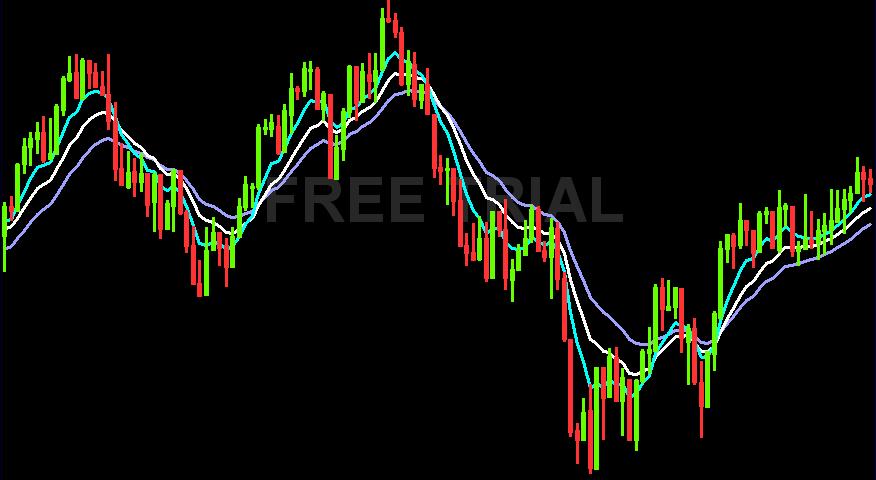Moving Average is a very popular indicator of technical analysis. It is broadly used because of its simplicity and possibility to combine several moving averages together. The basis is to select "n" - number of days during which the prices will be averaged. The next step differs according to the type of moving average we want to calculate. There are 3 basic types of moving averages - Simple moving average, Exponential moving average and Weighted moving average.
SMA - Simple Moving Average
Simple moving average formula:
(Price n + Price n-1 – ...Price n-x) / x+1
x+1 = number of days during which the moving average will be calculated. It is identical to the number of prices taken into consideration in the SMA construction.
Example: If today's price is 11 $, yesterday's 10 $ and the day before yesterday 10 $ as well, then a 3-day Simple moving average is calculated as follows: (11+10+10)/3, i.e. 10.33. Today's price is 11 $, 3-day moving average 10.33, so we can see immediately that the price became to rise, because it's above its moving average.
Simple moving average gives all the days, implied to the calculation, the same importance. It is the main disadvantage of Simple moving average. If the farthest day implied to the calculation is extremely High or Low, the moving average can change rapidly tomorrow. In other words, if the Simple moving average changes rapidly, it doesn't have to mean there was a steep increase/decrease in the price currently. It can also mean that the farthest day implied has just fall out of the calculation. It happens in case if the value was extremelly High or Low and suddenly it's not in the average implied.
This unpleasant limitation is solved by Exponential moving average.
EMA - Exponential Moving Average
Exponential moving average, unlike the Simple moving average, gives higher priority to the actual data. The current values get higher importance in the EMA calculation compared to the furthest ones.
EMA formula looks like follows:
Calculate the parameter "x" (a.k.a. Alpha or SC - smoothing constant):
x = 2/(n + 1)
n – chosen time period for the EMA calculation.
Example: If we calculate a 3-day's EMA, then x = 2/(3+1), i.e. 0.5.
EMA = (Ema n-1) + [x * (Price n – Ema n-1)]
Ema n-1 = EMA value of the previous day
Price n = Actual Price (Today's price)
Example: Should a 3-day EMA be 10 $ yesterday and today's price 11 $, then the calculation looks like follows: 10 + [0.5*(11–10)], what equals to 10.5. So the price rised to 11 $ and EMA rised to 10.5 $ from the yesterday's 10 $. As you can see from the example, there is higher importance given to the actual data.
WMA - Weighted Moving Average
The last frequently used moving average is a WMA - Weighted Moving Average. WMA gives every day, implied to the calculation, different weights. It is usual to give higher importance to actual days and lower importance to the furthest days. But it is up to you and your decision which day should be more or less significant.
WMA formula looks like follows:
[[(Price n * x)] + [Price n-1 * (y)] + …[Price n-2 * (z)]] / (x+y+z)
Price n = Actual price
Price n-1 = Price of the previous day
Price n-2 = Price of the day before yesterday etc.
x, y, z = importance given to every single day.
Example: Today's price is 11 $, yesterday's 10 $ and the day before yesterday also 10 $. We need to calculate 3-days WMA. The highest importance is given to the most actual day. The further the other days are, the lower weight is given to them. Calculation looks like follows: [(11*3) + (10*2) + (10*1)] / 6 = 10.5. The result shows that when price rised to 11 $, WMA rised to 10.5 $ as well.
In the end: We could see how the Moving Average calculations differ from each other. By the same entry data we got these results: SMA = 10.33; EMA = 10.50; WMA = 10.50.
EMA and WMA reached higher values, because they give higher significance to the actual data and follow better the prevailing conditions on the market.
Note: There are also other types of Moving averages used in technical analysis, of course. They arn't so famous and their construction is usually so complicated that we shall describe them in separate articles. For now we just mention some of the others like KAMA, HMA, FRAMA, DEMA, Vidya, T3 etc.
Now we will describe how to use the Moving averages for trading to make some profits.
How to use Moving Averages for trading
Moving averages are often used as a trend indicator so it can give us some hints when to go Long or Short. The main idea is quite simple - when Close price is above its moving average, we Buy, when it is bellow its moving average, we Sell. We change our positions every time the Close price crosses its MA. Because the Price/MA crossings can be very frequent, we can follow just he Moving Average curve. If it is rising, we buy, cause there is an Uptrend on the market. If the Moving average is decreasing, we Sell, because there is a Downtrend prevailing.

Copyright © Picture made by Incredible Charts
There is a Blue 10-days EMA, White 21-days EMA and a Violet curve for 42-days EMA displayed in the picture above.
It is important to realize that the shorter time period we use for Moving Average calculation, the closer the Moving Average moves to the Price graph. It means the more frequent the Price/Average crossings are and the more signals to trade are given. As they come very often, there is a lot of false signals that would lead to a loss trade (have a look at he blue curve). On the contrary, the longer time period for Moving average calculation we choose, the farther it is from the Price chart and the later we enter the trades. It means the signals are not so frequent but our profits are lower, too (have a look at the violet curve).
There is also another way how to use the Moving averages. Trader doesn't have to follow the Price/MA crossings. He can follow 2 Moving Average crossings, too (take a look at the White and Blue curve crossings. They would give us very nice and profitable signals). One of the EMA is shorter, the other one Longer - e.g. EMA3 and EMA21 combination.
In other words, if we choose to follow two EMA crossings, there is not so many signals and we don't have to change our positions so often. Close price can be bellow its MA already, but the shorter Moving average is still above the longer moving average so it keeps us in the trade. 2 Moving average crossings don't follow every small price swing, so they can be pretty robust. It is an advantage especially in case the trend remains longer and does not change very often. So we can get less false signals about trend reversals. It also means that if the trend really changes, we get the signal a bit later.
Moving averages are pretty useful during well trending markets. They keep us in the trade and don't allow to exit earlier than the trend really changes. It is also true that trading with Moving averages requires quite large amount of money. The Drawdown can be pretty high so we need some backup funds. It is because the Moving averages produce many signals during choppy market - i.e. when the market moves sideways. If there isn't any trend prevailing, the moving average crossings are quite frequent and there is a lot of loss trades made.
If you are interested in a deeper study of this technical indicator and prefer ready to serve solutions, this section may be of interest to you. There you can find all the available indicators in Excel file for download.
